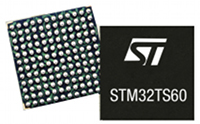Multi-touch displays support all ten fingers at once
Feb 18, 2010 — by LinuxDevices Staff — from the LinuxDevices Archive — 3 viewsThe French company Stantum is demonstrating multi-touch displays that can react to as many as ten fingers simultaneously. The Android-ready “PMatrix” technology permits the use of gloves or styli, responding to varying levels of pressure, according to the company.
According to Stantum, its PMatrix IP core and firmware watches every grid intersection of a touch-panel's matrix and reports any change of electrical characteristics, "delivering an exact image of what's happening on the touchscreen surface." As a result, the company claims, there's essentially no limit to the number of simultaneous touches a device can respond to.
Stantum says that where multi-touch implementations on the market today typically only respond to a maximum of four fingers at once, PMatrix-powered displays can easily react to all ten. They can also react to finger touches — on menus, for example — while simultaneously responding to a stylus, as pictured below.

Stantum's PMatrix technology in action
Stantum additionally claims that the "portable and lightweight" PMatrix technology, which requires no DSP (digital signal processor) and runs on a controller or any embedded processing device, improves the performance of resistive touchscreens so they can rival capacitive displays. While resistive screens have come to be viewed as old-fashioned in the post-iPhone world, they use less power than capacitive displays, Stantum points out. Most interesting perhaps, resistive screens can react to varying levels of pressure, the company adds.
 Last December, Stantum announced its Slate PC (right), a Windows 7 tablet PC based on Dell's Inspiron Mini 10. Equipped with a 10.1-inch resistive touchscreen, the device is intended as a proof-of-concept for PMatrix. As the video at the end of this story demonstrates, the Slate PC can apparently perform handwriting recognition, react to multiple fingers with a wide variety of gestures, and even be operated via touches as light as those of a camel's hair brush.
Last December, Stantum announced its Slate PC (right), a Windows 7 tablet PC based on Dell's Inspiron Mini 10. Equipped with a 10.1-inch resistive touchscreen, the device is intended as a proof-of-concept for PMatrix. As the video at the end of this story demonstrates, the Slate PC can apparently perform handwriting recognition, react to multiple fingers with a wide variety of gestures, and even be operated via touches as light as those of a camel's hair brush.

Stantum's SMK-4.3
At this week's Mobile World Congress (MWC), meanwhile, Stantum announced the SMK-4.3 (above), a hardware kit that's said to include a 4.3-inch resistive touchscreen display, a multi-touch controller board, and a USB connection to an application host processor. Demonstrated with a TI OMAP35xx platform, the SMK-43 will enable PMatrix technology on Android, Windows Mobile, and Symbian operating systems with the aid of the "Touch Park" software framework illustrated below, the company says.

Stantum's Touch Park framework
 According to Stantum, PMatrix is also supported by the STMicroelectronics STM32TS60 controller chip announced last month. The 7 x 7mm chip (right), suitable for devices ranging from phones to notebook PCs, is sampling now and will enter volume production in the second quarter of this year, STMicroelectronics says.
According to Stantum, PMatrix is also supported by the STMicroelectronics STM32TS60 controller chip announced last month. The 7 x 7mm chip (right), suitable for devices ranging from phones to notebook PCs, is sampling now and will enter volume production in the second quarter of this year, STMicroelectronics says.
Stantum says patents on its multi-touch technology, which could also be applied to capacitive screens in the future, date back to as early as 2004. The company has "no legal fear from Apple" over using multi-touch, according to an article posted last month by PC writer Sascha Segan.
Jim Meador, a senior manager at Stantum, was quoted as saying, "I have been unable to find anything from Apple that says they own the pinch gesture. Apple has done an amazing job scaring people away."
A demonstration of PMatrix on the Slate PC
Source: Netbooked
(click to play)
Availability
According to Stantum, its PMatrix technology could begin shipping in phones, tablets, and other devices during 2011. It's said demonstrations are being provided at Mobile World Congress Hall 2.1, Stand 2.1F67.
More information on PMatrix may be found on the Stantum website, here.
The PC item by Sascha Segan may be found here. A Laptop item with additional video may be found here.
This article was originally published on LinuxDevices.com and has been donated to the open source community by QuinStreet Inc. Please visit LinuxToday.com for up-to-date news and articles about Linux and open source.